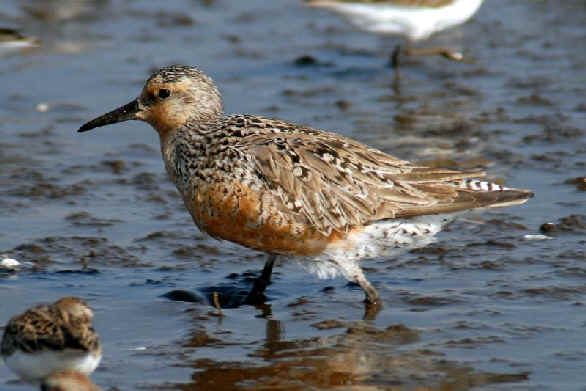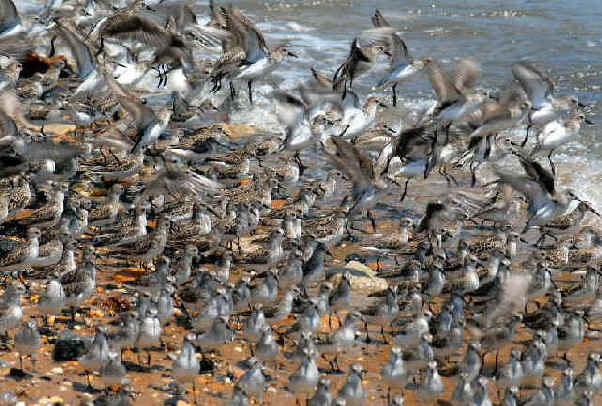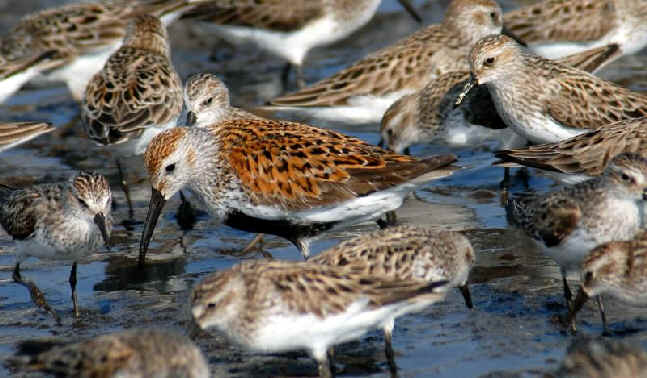 |
PO Box
9021, Wilmington, DE 19809, USA E-mail: font@focusonnature.com Phone: Toll-free in USA 1-888-721-3555 or 302/529-1876 |
 |
PO Box
9021, Wilmington, DE 19809, USA E-mail: font@focusonnature.com Phone: Toll-free in USA 1-888-721-3555 or 302/529-1876 |
Armas Hill has presented the "Birdline", originally from
Philadelphia, on the phone and internet for over 3 decades, and on the radio
in Delaware for about 10 years.
Links:
A List & Photo Gallery of North American Birds, in 6 Parts
A List & Photo Gallery of Argentina Birds, in 2 Parts
A List & Photo Gallery of Chile Birds, in 2 Parts
The
Birdline for June 13, 2005 & again July 27, 2006:
The following is special Birdline/FONT feature, as it was given on the Birdline
on the internet on June 13, 2005,
relating to KNOTS and other shorebirds that have staged annually over the years,
in the late-spring, along the shores of the Delaware Bay in the USA. That
phenomenon may not continue, in the future, to be what it has been.
Excerpts from the following feature were on the Birdline on the Radio on June 15 & 22, 2005 on radio station AM
1450 WILM in Wilmington, Delaware, where the Birdline was heard on Wednesdays
before 6am, 9am, and 7pm (Eastern Time). The Birdline on the Radio was heard
anywhere on the web.
The text of an additional Birdline Feature, given on the Birdlines on the
internet, on June 22, is also included before the end of the following text.

Red Knot
(Photo by Howard Eskin)
RED KNOTS IN AMERICA IN PERIL
in Chile, Argentina, Delaware & New Jersey, and northern Canada
written by Armas Hill
Thousands of miles away, in southern South America, there's a ferry that carries
mostly trucks and a few cars across the Strait of Magellan. Even though it's at
the eastern end of the strait, not far from the Atlantic, it's in Chile.
In the water, by the boat, there are COMMERSON'S DOLPHINS (with their beautiful
black and white pattern).
Also in the water, MAGELLANIC PENGUINS fish.
In the
sky, KING CORMORANTS fly (with black-and-white coloration, like the dolphins and
the penguins).
In the air, above the feeding penguins, there are SOUTH AMERICAN
TERNS emitting their raucous calls as they fly about.
SOUTHERN GIANT-PETRELS fly
by, ready to scavenge.
At a distance, over the sea, BLACK-BROWED ALBATROSSES
continuously glide up and down in arcs.
Also at a distance, on the beach,
there's a flock of SHOREBIRDS that only recently arrived from somewhere else.
It's November. When it's spring, going into summer, there, back here in the
Northern Hemisphere, from where the shorebirds came, it's fall, going into
winter.
All of the other wildlife just mentioned reside year-round in the
Southern Hemisphere. But the shorebirds have gone from one summer to another to
feed on the beach there, in the intertidal zone of mollusks and crustaceans.
The
SHOREBIRDS in a flock are RED KNOTS, the subspecies CALIDRIS CANUTUS RUFA, that
inhabits the Americas.
In that area of Chile, just referred to, nearly no people live. There are no
towns or cities. Even the ferry operators live in small settlements some
distance away. There's no pollution, and virtually no noise (other than what's
natural).
If one were to walk along the coast with the KNOTS, just a short
distance from the sound of the ferry, only surf and natural sounds such as the
raucous calls of the TERNS would be heard.
Also in southern Argentina, but a thousand miles to the north, along the
Atlantic, there are long and clean beaches that extend for miles.
Again, many of those miles are without people, pollution, and unnatural noise.
Along some stretches of that coast, in Patagonia, there are SEALS and SEA-LIONS,
KILLER WHALES and DOLPHINS, in and beyond the surf, and SOUTHERN RIGHT WHALES in
some of the bays.
Various GULLS and TERNS are throughout.
Also along parts of
that Argentine coast, there can be thousands of MANX SHEARWATERS (in November,
having come from the European side of the North Atlantic), and groups of
colorful BURROWING PARROTS that reside in the sandy coastal bluffs by the ocean.
Along the sandy beaches below the bluffs and beyond for many miles, there are
flocks of SHOREBIRDS. Again, during the Austral spring and summer, they are RED
KNOTS. Birds in these flocks until recently numbered in the thousands.
Inland, just a few miles, from one of those coastal locations in Argentina,
there's a large farm property with many acres of natural shrubby vegetation.
There's a lot of (natural) sound there, as the terrain is filled with
MOCKINGBIRDS of two species that are very vocal.
There are a number of
interesting landbirds, including one endemic to Argentina, the CARBONATED FINCH
(a sparkling bird!).
What has also been there is another songster, the YELLOW
CARDINAL (instead of being red & black as ours is, it's yellow and black).
The farm just described is owned by a man named Senor (or Mr.) Manana.
Yes, it's
true, "Senor Manana".
As the YELLOW CARDINAL that's been on his
property is prized as a cage bird, due to its beautiful song and striking
appearance, people sometimes come there to capture it.
With too much of that
unfortunate activity recently, that species has now been classified by Birdlife
International as "endangered", the second level after "critically
threatened". With too much of that activity, that species won't have too
many more "mananas" (or "tomorrows", in Spanish).
Down the highway a bit from Sr. Manana's farm, there's a hotel, where young
ornithologists have periodically stayed, the last few years, from October
onwards, as they have been banding the RED KNOTS on the nearby beaches.
In
conversations there at the hotel, even just a decade ago, it was not anticipated
that those SHOREBIRDS there would be declining as drastically as the pretty
songster, the YELLOW CARDINAL, down the road.
It now appears that the American
subspecies of the RED KNOT, Calidris canutus rufa, also, may not have too many
more "mananas".
About a week before I wrote this essay (back on Sunday, June 5, 2005), in
Delaware USA, people from the division of fish & wildlife of that state,
were continuing their efforts to monitor the SHOREBIRDS along the Delaware
Bayshore, as they had been doing every year since 1997.
Along the coast that
day, near South Bowers Beach, there was a lingering group of SHOREBIRDS that
contained about 600 KNOTS, 600 SANDERLINGS, 1,500 RUDDY TURNSTONES, and 1,500
SEMIPALMATED SANDPIPERS.
During 6 hours with the birds that day, the researchers
found about 50 marked, or banded, birds. About half of them were RED KNOTS,
marked during the previous three years (2002-2004), with some lime flags. At
least 1 was flagged in Chile (maybe by the beach by the Strait of Magellan), and
3 of the KNOTS were flagged in Argentina (probably on the Atlantic beach in
northern Patagonia, near Senor Manana's farm).
Every year, the RED KNOTS, Calidris canutus rufa, make a nearly 18,000-mile
round-trip journey between Argentina & Chile and far-northern North America
(Arctic Canada), where they nest.
The first stage of their northbound migration
includes, as it has for a long, long time, a 3 to 4 thousand mile flight
(usually non-stop) to the Delaware Bay shores. Upon their arrival, the hungry
birds must feed on the HORSESHOE CRAB EGGS, laid on the beach at that time of
year, in the late-spring. That feeding is necessary for the birds to continue,
with the needed energy, on the rest of their migration, with yet another long
flight to northern Canada. The RED KNOT depends almost exclusively on the
HORSESHOE CRAB EGGS to successfully complete the migration to their nesting
grounds.
The RED KNOT population, visiting the Delaware Bay shores in the spring, has
numbered more than 150,000 birds.
Recent surveys, however, have shown that
number has dropped dramatically to an estimated 15,000 birds.
In the last 10
years, according to these studies, this RED KNOT population has declined more
than 90%.
Surveys in the Delaware Bay area have fluctuated from about 16,000 in 2003 down
to about 13,000 in 2004, then up to about 15,000 in 2005.
Added to this is a sad statistic relating to a recent survey in South
America.
In 2005, there, only 17,600 KNOTS were counted, a decline of 40% from the
previous year.
If some real action is not taken, and taken soon, to change this situation, the
species here may well be extinct in just years, by the end of the current
decade. That action needs to be taken to prevent that outcome.
The RED KNOT, in
the Americas, may now be said to be the most endangered SHOREBIRD POPULATION in
the world.
The Secretary of the Interior, Gale Norton, in an interview around the time when
I wrote this essay last year, said that examination was underway regarding some
quick action for the listing of the KNOT as a federally Threatened Species. That
would have bypassed some usual procedures for such a listing, which can take as
much as 20 years. (The RED KNOT simply does not have that much time - that many
"mananas".)
In this instance, federal officials estimated that they
could make the decision within 18 months, as to the listing of the bird as
federally "Threatened". (Does anyone know what happened in
this regard?)
Not just the RED KNOT, but 5 other species of SHOREBIRDS, are dependent upon the
HORSESHOE CRAB EGGS along the Delaware Bayshore.
In 2005, according to New Jersey's chief endangered species biologist, surveys
of HORSESHOE CRAB EGGS in New Jersey and Delaware indicated, where as normally
4,000 eggs are laid per meter, the count was about 1,500. That was not good.
Also, in both New Jersey and Delaware, HORSESHOE CRAB EGGS have been harvested,
with annual harvests being about 150,000.
Thus, in certain years, there have
been 300,000 less HORSESHOE CRABS, depleting further the food supply needed by
the RED KNOT and 5 other species of SHOREBIRDS.
A group of 11 organizations (in 2005) joined together to petition the state
governments of New Jersey and Delaware, with a proposal of 4 specific actions
urgently needed to save the situation, due to all the evidence that there is of
a "death spiral" for the RED KNOT.
The 11 organizations: the American Bird Conservancy, the American Littoral
Society, Citizens Campaign for the Environment, Defenders of Wildlife, the
Delaware Audubon Society, the Delaware Riverkeeper, the National Audubon
Society, the New Jersey Environmental Federation, the NJ Public Interest
Research Group, and the Sierra Club.
The 4 actions:
1) institution of a moratorium on HORSESHOE CRAB harvesting
2) support efforts in surrounding states to enact such a moratorium and measures
to conserve the shared resource
3) support efforts to federally list the RED KNOT, Calidris canutus rufa, under
the Endangered Species Act
4) continue bay-wide efforts to reduce human harassment (of all kinds) of
forging SHOREBIRDS
Our time here is now up. Let's hope that soon it won't be for the RED KNOT, as
it has been in the Americas. But it may already be too late. It's time may soon
be up, and it may not have too many more "mananas".
There's more information regarding the history of SHOREBIRDS along the
Delaware Bay, in the following Birdline Feature that was given on the internet,
on Birdline Delaware and the Philadelphia Birdline, on June 22, 2005, as
continuation of the preceding June 13th feature:
Last time, during our feature referring to the RED KNOT, it was noted that
in 2004, survey-work indicated that the late-spring staging population along the
Delaware Bayshore was about 13,000 birds. That's considerably less than what the
population was a couple decades ago.
It was also noted last time that the RED KNOT is just one of about a half-dozen
species of SHOREBIRDS that stage in the late-spring along the shores of the
Delaware Bay.
Now, let's go back to 2 decades ago to look at what numbers of SHOREBIRDS along
the Delaware Bay were at THAT TIME. This look is to give a better perspective.
The information that follows is from an essay in the book, "Birds of
Delaware" by Gene Hess, Richard West, Maurice Barnhill, and Lorraine
Fleming. The essay, entitled "Spring Shorebirds on Delaware Bay" was
by Howard Brokaw. Of course, we can only cover here part of what's in that
essay.
Over 90 per cent of the SHOREBIRDS that flock in the late-spring along the
Delaware Bay are of 4 species: SEMIPALMATED SANDPIPER, RUDDY TURNSTONE, RED
KNOT, and SANDERLING.

On May 29, 2006, this
flock of Semipalmated Sandpipers
was along the Delaware Bay at Port Mahon, in Delaware.
(Photograph by Howard Eskin)
Smaller numbers of SHORT-BILLED DOWITCHERS and DUNLIN also occur. That makes 6
species of SHOREBIRDS in addition to LAUGHING GULLS that feed on the HORSESHOE
CRAB EGGS on the beach. Also, about a dozen other species of SHOREBIRDS occur in
the area in the spring.

Semipalmated Sandpipers
(photo by Howard Eskin)
During the years 1982 to 1995, as many as 272,000 SEMIPALMATED SANDPIPERS were
counted on both shores (Delaware & New Jersey) of the Delaware Bay.
The
high-day of the year, during that period, averaged 112,000.
After 1988, no
day-count exceeded 100,000.
These SEMIPALMATED SANDPIPERS fly non-stop 2,700 miles from Surinam, in northern
South America, to the Delaware Bay shores. It is an astonishing journey, really,
for those small birds - smaller yet, weighing less than an ounce when they
arrive.
Once by the Bay, they fuel up on the HORSESHOE CRAB EGGS, as they must,
to continue their migration north. This feeding is also necessary, in the same
way, for the same reason, for the other shorebird species about to mentioned.
During the years just referred to, the annual high-day for RUDDY TURNSTONES
averaged 70,000. It was as high as 108,000 in 1989.
The TURNSTONES by the
Delaware Bay in May probably represent about three-quarters of the eastern North
American population. These birds winter from South Carolina south to southern
South America, along the Atlantic Coast.
With their sturdy bills, TURNSTONES not only turn stones, they also dig holes in
the sand to expose more HORSESHOE CRAB EGGS. They thus provide what could be
called a FORAGING SERVICE for other shorebirds.
Regarding RED KNOTS, most of which migrate to the Delaware Bay from as far south
as Tierra del Fuego (in far-southern South America), nearly as many as 100,000
have been counted during one day (96,000). The average high-day for the species
during the survey period (1982-1995) was 48,000.
Many of the SANDERLINGS that stage by the Delaware Bay in May come mostly from
wintering-quarters in Brazil. But some also come from the sandy coasts of Peru
and Chile on the Pacific side of South America. A few winter further north, in
for example, Florida.
The maximum high-count for SANDERLINGS by the Delaware Bay
in May started to decline in the early 1980's. From 56,000 in 1982, it dropped
steadily to a level of 10,000 in 1993, 1994, & 1995.
That decline followed a
substantial decrease of perhaps 80 per cent of the SANDERLING population along
the East Coast of the USA from 1972 to 1982, continuing the downward spiral.
Generally, over the years, in the Delaware Bay area, SANDERLINGS have been more
to the south, closer to the mouth of the Bay.
To continue our look back at SHOREBIRDS by the Delaware Bay, and to continue our
effort to get a good perspective of what has been, we'll go now to the writings,
done back in 1937, by one of the foremost ornithologists of the region in those
days, Witmer Stone. His work, published that year, was entitled "Bird
Studies at Old Cape May".
What Witmer Stone did NOT refer to in that work were LARGE FLOCKS of SHOREBIRDS
as just mentioned, being by the Bay on the New Jersey side, at places such as
Reed's Beach, where since then such large flocks have been.
One could assume,
wrongly perhaps, that those flocks of KNOTS and TURNSTONES and the like were
there, but that Mr. Stone did not know about them. However, when reading through
his book, it's apparent that ornithologists of that day did know what was about,
and so another assumption can be made that such large flocks simply weren't
there.
What Witmer Stone did refer to was the rampant shooting of SHOREBIRDS that
formerly took place along the coast.
The RED KNOT, he said, was known to the
gunners as the "ROBIN SNIPE" or "RED-BREASTED SNIPE".
It,
along with the DOWITCHER (in those days a single species), before the shooting
was abolished, were among the most desirable of the SHOREBIRDS from the gunner's
standpoint, as they both decoyed easily. Thus, they both, according to Stone,
"nearly approached extermination".
The accounts in Stone's 1937 book refer to KNOTS occurring in southern New
Jersey, in the early part of the 20th Century, in small groups of 150 or so, or
in "low numbers" of less than a hundred. He relates that a gunner, for
instance, in late-May 1907, shot 29 of them in Cape May County.
Something very important in relation to SHOREBIRDS happened in 1913. That year,
the Federal Migratory Bird Law went into effect and the season was CLOSED on ALL
shorebirds except the WOODCOCK, BLACK-BELLIED PLOVER, GOLDEN PLOVER, and SNIPE
(known then as the WILSON'S SNIPE, as it's now known again today), and the two
species of YELLOWLEGS.
In 1926, the two species of PLOVERS were put on the protected list, and in 1927
the YELLOWLEGS followed them.
The season on WOODCOCK and SNIPE, the only two "shorebirds" remaining
on the game list, was subsequently reduced to one month with a bag limit.
Populations of the SHOREBIRDS of coastal New Jersey were monitored in the late
1920's and early 1930's. During that period, let's pick a year - 1931.
For that
year, here's a ranking of SHOREBIRD SPECIES in NJ, during their northward spring
migration in May, listing the most common first, and then those less so in
descending order:
1) Semipalmated Sandpiper
2) Ruddy Turnstone
3) Black-bellied Plover
4) Semipalmated Plover
5) Greater Yellowlegs
6) Sanderling
7) Least Sandpiper
8) Dowitcher (nearly all Short-billed of course, but in those days as
noted, it was a single species)
9) Whimbrel (then called Hudsonian Curlew)
10) (Red) Knot
11) Dunlin (called Red-backed Sandpiper)
12) Lesser Yellowlegs
13) Western Sandpiper

A Dunlin surrounded by
Semipalmated Sandpipers
(photo by Howard Eskin)
The following SHOREBIRDS, overall during the period 1929-1934, were classified
in New Jersey as "abundant" or "very common": SEMIPALMATED
SANDPIPER, SEMIPALMATED PLOVER, SANDERLING, DOWITCHER, LEAST SANDPIPER, GREATER
YELLOWLEGS.
Notice, now, that the RED KNOT was in the second category, those classified as
"common".
In that grouping, there were these species: BLACK-BELLIED
PLOVER, KILLDEER, RUDDY TURNSTONE, DUNLIN, RED KNOT, WESTERN SANDPIPER, LESSER
YELLOWLEGS (less common during the northbound migration than during the
southbound), WHIMBREL, PECTORAL SANDPIPER, SPOTTED SANDPIPER.
The author Peter Matthiessen wrote a fine book about SHOREBIRDS, published in
1967, and entitled "The Wind Birds".
In it, he also alluded to the
widespread shooting of shorebirds that was referred to by Witmer Stone. That
shooting was very prevalent in the late 1800's. It also continued in the early
1900's, even as some species started to show significant declines.
Matthiessen
wrote that "under the circumstances, it's a wonder that any SHOREBIRDS
survived into the 20th Century". They were shot in numbers, and they were
trapped. There was even a practice of "fire-lightning", that was
commonly done, for example on Long Island NY, when after dark resting flocks of
shorebirds, blinded by a bright beam, stood by while men stepped out from punts
and wrung their necks.
Among the gunners of that era, KNOTS and DOWITCHERS, as noted earlier, were
favorites. So were GOLDEN PLOVERS and ESKIMO CURLEWS, not only because of their
fine taste and great numbers (yes, even so for the CURLEW), but also because
they were unsuspicious to a fault. The ESKIMO CURLEW would circle back over the
guns, calling out to its fallen companions. That was a habit shared by the
DUNLIN, DOWITCHER, and other species. The DUNLIN was called "the
simpleton" by Long Island hunters, reflecting the low esteem in which its
brain was held.
After the legal protection for SHOREBIRDS came to be, as noted in
1913, for a
number of species, through the 20th Century, things improved. For the ESKIMO
CURLEW, it was too late.
Yes, SHOREBIRDS that at one time exist by the thousands, can in time disappear.
The following is a passage from Alexander Wilson's "American
Ornithology", written in the early 19th Century:
"Everyone who has been on the shore, on a day gleaming and cloudy, may have
seen MASSES of these birds at a distance, appearing like a dark and swiftly
moving cloud, suddenly vanishing, but then in a second, appearing at some
distance, glowing with a silvery light almost too intense to gaze upon. These
are the consequences of the simultaneous motions of the flock, at once changing
their position, showing the dark gray of their backs, or the pure white of their
underparts."
With these words, Alexander Wilson was writing about the KNOT (in its winter
plumage). In his day, the bird was called the "ASH-COLORED SANDPIPER".
The scientific name, "CALIDRIS CANUTUS", refers to King Canute, who
loved to eat it (the species does have a European population).
4 books, written over the years, have already been noted in this essay.
Here's
another one: "The Flight of the Red Knot" by Brian Harrington and
Charles Flowers, published in 1996. If you can get it, it's interesting, and
with good background about the KNOT.
Now (in July), the SHOREBIRDS that migrated north to the Arctic to nest, including the RED
KNOT, are on their way south.
FONT (Focus On Nature Tours) goes to southern South
America, to Argentina & Chile. Although people don't normally travel to the
opposite end of the world to see birds that migrate from their homelands, it is
a nice experience to see the places where these birds go. And it's fascinating
in a way to share the long migration of the KNOTS and other SHOREBIRDS.
Places to be visited in southern South America referred to in this bulletin
include:
PATAGONIAN ARGENTINA: the coastal region with the miles of beaches, and Senor
Manana's farm (with the YELLOW CARDINAL), north of the Valdez Peninsula, and
TIERRA DEL FUEGO, in far-southern ARGENTINA.
During FONT Argentina tours, in addition to the YELLOW
CARDINAL and RED KNOT, other birds and wildlife in preceding text have been seen,
including: MAGELLANIC PENGUIN (including a colony with a million), SOUTHERN
GIANT-PETREL, BLACK-BROWED ALBATROSS, MANX SHEARWATER, SOUTH AMERICAN TERN,
BURROWING PARROT, CARBONATED FINCH, and SOUTHERN RIGHT WHALE, KILLER WHALE (or
ORCA), and SEALS and SEA-LIONS. And that's just some of the nature that we've
observed!